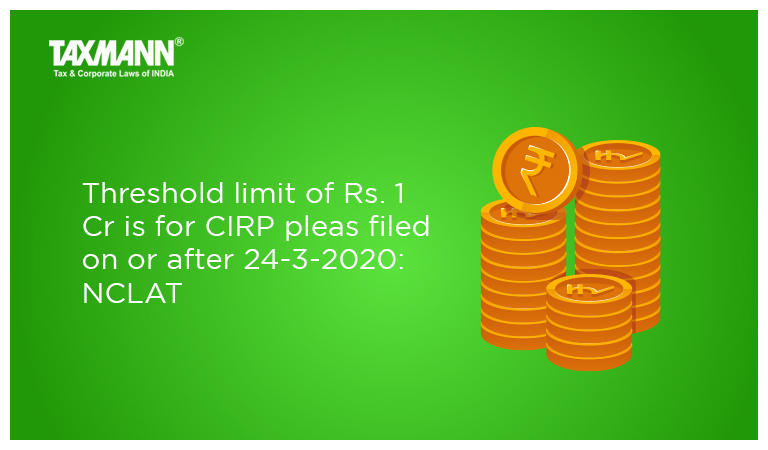Threshold limit of Rs. 1 Cr is for CIRP pleas filed on or after 24-3-2020: NCLAT
- Blog|News|Insolvency and Bankruptcy Code|
- 3 Min Read
- By Taxmann
- |
- Last Updated on 23 August, 2022

Case Details: Metal’s & Metal Electric (P.) Ltd. v. Goms Electricals (P.) Ltd. - [2022] 141 taxmann.com 134 (NCLAT-Chennai)
Judiciary and Counsel Details
-
- M. Venugopal, Judicial Member & Kanthi Narahari, Technical Member
- E.K. Kumaresan & Dr Kamlesh Vaidankar, Advs. for the Appellant.
- B. Ramana Kumar & Harish Kumar, Advs. for the Respondent.
Facts of the Case
In the instant case, the applicant had sold and supplied the goods as an operational creditor to the corporate debtor and the corporate debtor had received, accepted and utilised those goods. The corporate debtor had never raised any dispute as to the quality or quantity of the material supplied.
The operational creditor had issued a demand notice dated 10-10-2020 u/s 8 of the IBC to the corporate debtor. On the corporate debtor’s failure to pay, the operational creditor filed an application u/s 9 of the IBC.
NCLT Held
The NCLT observed that the amount claimed was in a sum of Rs. 17,91,112 and on and from 24-3-2020 the pecuniary jurisdiction for entertaining the petition under the provisions of sections 7, 9 and 10 stands in relation to threshold limits increased from Rs. 1,00,000 to Rs. 1,00,00,000.
The NCLT held that the petition was filed on 12-3-2021 i.e much after 24-3-2020 being the date of increase of the threshold limit and thus, in the circumstances, it had no jurisdiction to entertain the petition and was constrained to dismiss the same for ‘lack of pecuniary jurisdiction’.
Thereafter, an appeal was made to the National Company Law Appellate Tribunal (NCLAT) against the order passed by the NCLT.
The operational creditor contended that the amount in default was Rs. 17,91,112 and the correct interpretation of the Notification dated 24-3-2020 was that in case of ‘default’ that takes place on or after 24-3-2020, the threshold limit would be Rs. 1,00,00,000. As such, if a ‘default’ had been committed by a ‘corporate debtor’ before the issuance of the Notification i.e., prior to 24-3-2020, then, for the purpose of initiation of CIRP u/s 9 of the IBC the threshold limit would be considered as Rs. 1 lakh.
The NCLAT observed that section 4 of the IBC specifies the minimum threshold limit of Rs. 1,00,00,000 for the default and in fact, the Central Government had raised the limit from Rs. 1,00,000 to Rs. 1,00,00,000 as per Notification No. S.O 1205 (E), dated 24-3-2020.
The NCLAT, further observed that the date of initiation of CIRP shall be the date on which an application was made. To put it precisely, ‘the date of default’ is not to come into ‘operative play’ and the same ought not to be taken into account for anything but computing the period of limitation.
The NCLAT held that the threshold limit of Rs. 1 crore specified in Notification No. 1205(E), dated 24-3-2020 will be applicable for applications filed u/s 7 or 9 on or after 24-3-2020.
Further, the NCLAT held that where application u/s 9 of the IBC was filed on 12-3-2021 involving debt lower than the threshold limit, the said application was not maintainable because of lack of pecuniary jurisdiction.
Thus, the impugned order passed by the NCLT dismissing said section 9 application was free from legal infirmities.
List of Cases Reviewed
-
- Order of NCLT in CP/IB/23/CHE/2021 dated 15-3-2021 (para 29) affirmed.
List of Cases Referred to
-
- Madhusudan Tantia v. Amit Choraria [2021] 131 taxmann.com 144 (NCLAT – New Delhi) (para 8)
- Jumbo Paper Products v. Hansraj Agrofresh (P.) Ltd. [2022] 139 taxmann.com 16 (NCLAT – New Delhi) (para 14)
- Tharaken Web Innovations (P.) Ltd. v. National Company Law Tribunal [2022] 135 taxmann.com 187/171 SCL 386 (Ker.) (para 15)
- SS Group (P.) Ltd. v. Shiva Asphaltic Products (P.) Ltd. [C.P. (IB) No. 568 of 2021, dated 3-1-2022] (para 16)
- Ramesh Kymal v. Siemens Gamesa Renewable Power (P.) Ltd. [2021] 124 taxmann.com 226/164 SCL 455 (SC) (para 17).
Disclaimer: The content/information published on the website is only for general information of the user and shall not be construed as legal advice. While the Taxmann has exercised reasonable efforts to ensure the veracity of information/content published, Taxmann shall be under no liability in any manner whatsoever for incorrect information, if any.

Taxmann Publications has a dedicated in-house Research & Editorial Team. This team consists of a team of Chartered Accountants, Company Secretaries, and Lawyers. This team works under the guidance and supervision of editor-in-chief Mr Rakesh Bhargava.
The Research and Editorial Team is responsible for developing reliable and accurate content for the readers. The team follows the six-sigma approach to achieve the benchmark of zero error in its publications and research platforms. The team ensures that the following publication guidelines are thoroughly followed while developing the content:
- The statutory material is obtained only from the authorized and reliable sources
- All the latest developments in the judicial and legislative fields are covered
- Prepare the analytical write-ups on current, controversial, and important issues to help the readers to understand the concept and its implications
- Every content published by Taxmann is complete, accurate and lucid
- All evidence-based statements are supported with proper reference to Section, Circular No., Notification No. or citations
- The golden rules of grammar, style and consistency are thoroughly followed
- Font and size that’s easy to read and remain consistent across all imprint and digital publications are applied



 CA | CS | CMA
CA | CS | CMA
